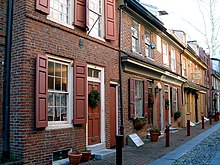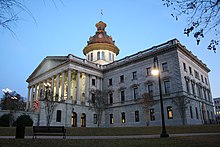Federal architecture
Architectural style in the USA / From Wikipedia, the free encyclopedia
Dear Wikiwand AI, let's keep it short by simply answering these key questions:
Can you list the top facts and stats about Federal period architecture?
Summarize this article for a 10 years old
Federal-style architecture is the name for the classicizing architecture built in the newly founded United States between c. 1780 and 1830, and particularly from 1785 to 1815, which was heavily based on the works of Andrea Palladio with several innovations on Palladian architecture by Thomas Jefferson and his contemporaries first for Jefferson's Monticello estate and followed by many examples in government building throughout the United States. An excellent example of this is the White House. This style shares its name with its era, the Federalist Era. The name Federal style is also used in association with furniture design in the United States of the same time period. The style broadly corresponds to the classicism of Biedermeier style in the German-speaking lands, Regency architecture in Britain, and to the French Empire style. It may also be termed Adamesque architecture. The White House and Monticello were setting stones for federal architecture.







In the early American republic, the founding generation consciously chose to associate the nation with the ancient democracies of Greece and the republican values of Rome. Grecian aspirations informed the Greek Revival, lasting into the 1850s. Using Roman architectural vocabulary,[2] the Federal style applied to the balanced and symmetrical version of Georgian architecture that had been practiced in the American colonies' new motifs of neoclassical architecture as it was epitomized in Britain by Robert Adam, who published his designs in 1792.